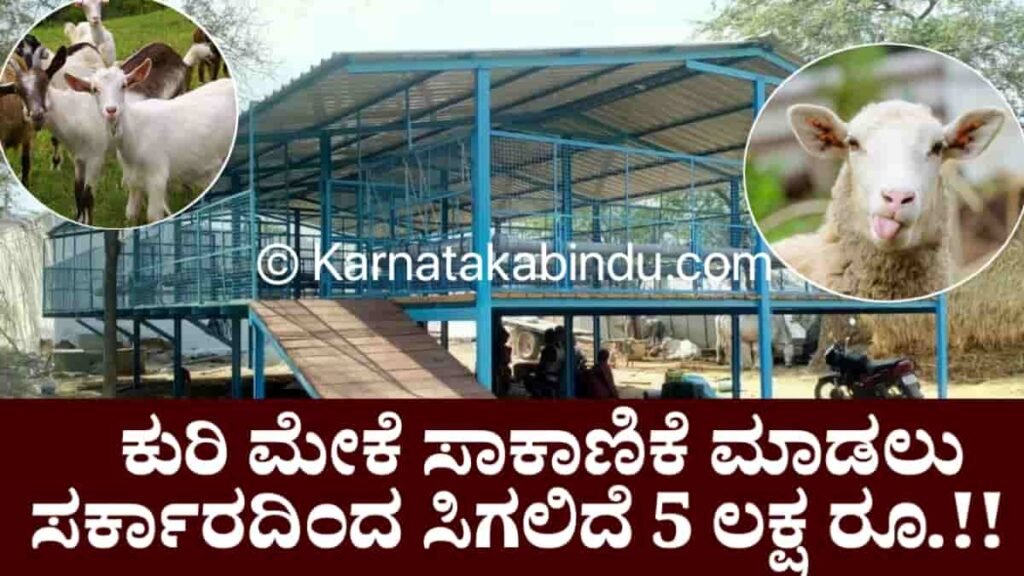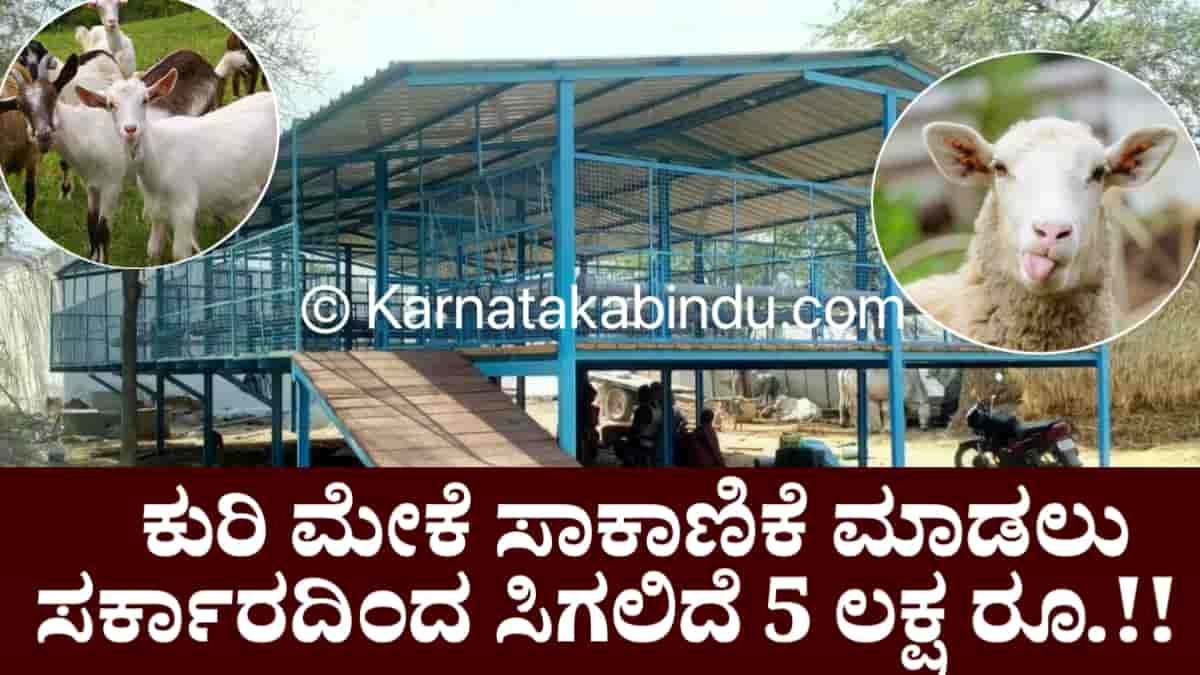Introduction
Goat and sheep farming has always played an important role in Karnataka’s rural economy. For many families, especially in villages, these animals are more than just livestock. They are a source of milk, meat, wool, manure, and income. Even with limited land, farmers can raise goats or sheep and earn steady profits.
But one of the biggest challenges for small farmers has been providing proper shelter for animals. Without a well-built shed, goats and sheep face several problems—exposure to heat, rain, and cold, increased disease risk, and vulnerability to predators. Recognizing this issue, the Karnataka government has introduced a financial subsidy of up to ₹5 lakh to help farmers build sheds under the “20+1 Unit Scheme.”
This move is expected to not only improve the living conditions of livestock but also boost the confidence of farmers to expand goat and sheep farming as a sustainable business.
Why a Shed Is Important in Goat and Sheep Farming
Many farmers traditionally kept their animals in open areas or makeshift shelters made from bamboo, wood, or thatch. While these temporary shelters might save money in the short term, they often create bigger problems later.
A proper shed offers:
- Protection from Weather: Goats and sheep are sensitive to excessive heat, rain, and cold. A shed keeps them safe throughout the year.
- Disease Prevention: Clean flooring and good ventilation reduce chances of infections and parasites.
- Safe Environment: Proper walls and fencing keep animals away from predators like dogs, foxes, or even snakes.
- Better Productivity: Healthy, stress-free animals grow faster, give better milk yield, and breed more regularly.
- Easy Management: Feeding, cleaning, and health check-ups become much easier when animals are kept in organized spaces.
In short, a shed is not an extra luxury—it is a basic need for successful goat and sheep farming.
The 20+1 Unit Scheme
The subsidy for shed construction is provided under the 20+1 Unit Scheme. The idea behind this scheme is to encourage farmers to rear at least 20 goats or sheep along with one breeding male.
The government understands that starting such a unit requires investment—not only in buying animals but also in creating housing, feeding arrangements, and healthcare facilities. By offering ₹5 lakh financial assistance for shed construction, the scheme reduces the burden on farmers and motivates them to take up livestock farming seriously.
Eligibility for the Subsidy

While the exact guidelines may vary slightly by district, the general eligibility conditions include:
- The applicant must be a resident farmer of Karnataka.
- Priority is given to small and marginal farmers, women farmers, and those belonging to Scheduled Castes and Scheduled Tribes.
- The farmer should have enough space to construct the shed and maintain the animals.
- A simple application form must be submitted to the concerned Animal Husbandry Department or through the local Gram Panchayat.
Farmers are usually required to attach documents such as Aadhaar, caste certificate (if applicable), land details, and a plan or estimate for the shed construction.
How to Apply
- Visit Local Office: Farmers need to approach the Department of Animal Husbandry and Veterinary Services in their district.
- Collect Application Form: Fill in details such as name, address, type of farming, number of animals, and shed requirements.
- Attach Documents: Aadhaar card, residence proof, land ownership or lease papers, and bank account details are usually required.
- Submit Estimates: Farmers may need to attach a cost estimate for the shed construction.
- Verification and Approval: Officials will inspect the site and approve the application if it meets guidelines.
- Sanction of Subsidy: Once approved, the subsidy amount is sanctioned and released in stages—either before or after completion of work, depending on the scheme rules.
Features of an Ideal Shed
The government subsidy covers construction costs, but the responsibility of designing a good shed rests with the farmer. Here are some recommended features:
Location
- Select high ground to avoid waterlogging.
- Ensure good drainage and easy access for cleaning and feeding.
Flooring
- Concrete or cement floors are best for hygiene.
- In low-cost options, compacted soil with proper slope can also work.
- Raised slatted floors help in keeping waste away from animals.
Roofing
- Roof should protect animals from rain and sun.
- Tiles, cement sheets, or metal sheets are commonly used.
- A sloped roof ensures that rainwater drains easily.
Ventilation
- Adequate windows or open grills should be provided for airflow.
- Poor ventilation can lead to respiratory diseases.
Space Requirement
- On average, each goat or sheep requires about 10 square feet of floor area.
- Special pens should be created for kids, breeding males, and sick animals.
Additional Features
- Water supply and feeding troughs inside the shed.
- Fencing or compound wall for safety.
- Storage area for fodder and medicines.
Benefits of the Subsidy
The ₹5 lakh subsidy is not just financial aid—it has larger benefits for rural communities:
- Lower Initial Investment: Farmers save money while building quality sheds.
- Encouragement for Youth: Many young people hesitate to enter farming. Such schemes give them confidence to start livestock businesses.
- Women Empowerment: Women often take care of goats and sheep. By receiving financial support, their role in family income grows stronger.
- Increased Productivity: Healthy animals mean more milk, meat, and wool production.
- Job Creation: Shed construction creates temporary work for local masons, carpenters, and laborers.
Challenges That Farmers May Face
While the subsidy is promising, farmers should also be aware of challenges:
- Delayed Paperwork: Processing applications may take time if documents are incomplete.
- Awareness Gaps: Many rural farmers do not know about such schemes. Awareness campaigns are needed.
- Maintenance Costs: Even after building sheds, regular cleaning and repairs are necessary.
- Market Access: Higher production is valuable only when farmers get good prices in markets.
How Farmers Can Make the Most of It
To benefit fully from this subsidy, farmers should:
- Form Self-Help Groups (SHGs): Applying as a group increases chances of approval.
- Seek Veterinary Guidance: Regular check-ups keep animals healthy.
- Adopt Scientific Practices: Balanced feeding, vaccination, and breeding improve profits.
- Combine with Other Schemes: Farmers can also avail fodder subsidy, insurance, and bank loans for expansion.
Important links
official website
Click here
Real-Life Impact
Imagine a small farmer in a village who owns just five goats. Without a proper shed, these animals often fall sick during rainy season. He hesitates to expand farming due to high costs.
With the government subsidy, he constructs a strong shed worth ₹6 lakh, out of which ₹5 lakh comes as assistance. Within two years, his goat herd grows to 25. He sells milk and kids, earning steady monthly income. His family becomes financially stable, and neighbors are encouraged to apply for the scheme as well.
This is the kind of transformation the government aims to achieve—turning livestock farming into a reliable livelihood source for thousands of rural households.
Conclusion
The Karnataka government’s decision to provide a ₹5 lakh subsidy for goat and sheep shed construction is a welcome step. It addresses a very practical problem—animal housing—that directly impacts farmer income and livestock health.
By combining this support with good training, veterinary care, and market linkages, goat and sheep farming in Karnataka can become a model for profitable rural enterprise. For farmers, this is the right time to take advantage of the scheme, build proper sheds, and secure a healthier and more prosperous future.
